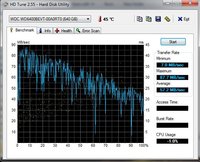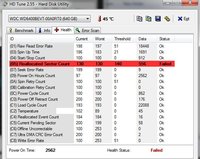You are using an out of date browser. It may not display this or other websites correctly.
You should upgrade or use an alternative browser.
You should upgrade or use an alternative browser.
Check it with hdtune and post results.
Can't exactly pin point the reasons but your HDD is failing.
Wikipedia said:Count of reallocated sectors. When the hard drive finds a read/write/verification error, it marks that sector as "reallocated" and transfers data to a special reserved area (spare area). This process is also known as remapping, and reallocated sectors are called "remaps". The raw value normally represents a count of the bad sectors that have been found and remapped. Thus, the higher the attribute value, the more sectors the drive has had to reallocate. This allows a drive with bad sectors to continue operation; however, a drive which has had any reallocations at all is significantly more likely to fail in the near future.[2] While primarily used as a metric of the life expectancy of the drive, this number also affects performance. As the count of reallocated sectors increases, the read/write speed tends to become worse because the drive head is forced to seek to the reserved area whenever a remap is accessed. A workaround which will preserve drive speed at the expense of capacity is to create a disk partition over the region which contains remaps and instruct the operating system to not use that partition.


